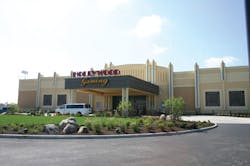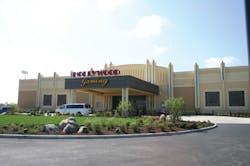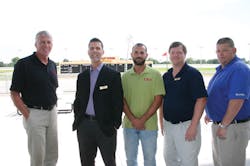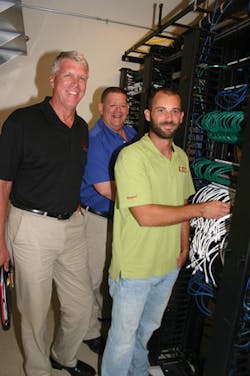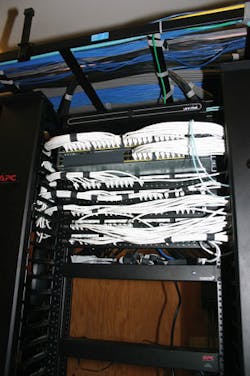By Susan Larson, Berk-Tek
As soon as the new Racino entertainment complex opened, residents from Dayton, OH and surrounding towns flocked to try their hands at Lady Luck on the venue’s new video gaming equipment. Slot machines are no longer “one-armed bandits”; they have been replaced by new digital video lottery terminals (VLTs) and winning is based on random algorithms.
Racino, which is part of the Hollywood Casino franchise owned by Penn National Gaming, sits on 170 acres. This newly constructed multi-building complex features a gaming facility with 1,000 VLTs, a sports bar and food court, retail shops, an outdoor horse track, a horse paddock (stalls) and outbuildings. Built from the ground up, bets were on as to whether or not the facility would be completed on time in 10 months due to many challenges, including one of the worst winters on record.
“This Racino location is similar to many of our other 28 national Hollywood Casino locations in fit and form, except the focus is on video terminals and horse racing, and this location does not have any table games,” says Brad Wagner, IT manager at Penn National Gaming. The facility is divided into two sections, a front section and a back section. The front section houses the casino, dining area, and a stage. The back section houses the offices, the race track, and the customer betting and seating area. There are also different small structures that required network cabling-camera towers, parking lot towers, vet trailers, VIP areas, the paddock, and the maintenance building. “Providing a reliable and secure infrastructure to handle the many different IP applications in such a challenging layout is key to our operations,” Wagner says.
The winning team of Chapel Electric of Dayton, OH and their sister company, Chapel Romanoff Technologies (CRT) collaborated to provide Racino with an efficient and reliable infrastructure. The CRT team included Dennis Severance, RCDD, vice president of operations; Jeff Carr, project manager; and Lee Olinger, general foreman. CRT specified the indoor and outdoor cable plant, and Chapel Electric designed the pathway system. For CRT, installing so many different cable types created challenges because the “workstations” were very diverse. The network infrastructure had to support multiple applications and devices including voice (VoIP) and data in the offices, VLTs on the casino floor, outdoor digital signage, a clocking system around the track, and data to the horse stalls. Additionally, throughout the complex, the network infrastructure connects security cameras, retail point-of-purchase devices, and AV systems. All of these IP devices had to be integrated into a converged IP network.
The CRT-led team also included Michael Raiser Associates (MRA), a nationally known technology consultant specializing in the hospitality market segment, as well as Turner, who served as the general contractor. Together, the project team was faced with adhering to extremely tight deadlines, harsh winter conditions and a multifaceted network layout. The team had to plan and install three different networks including separate backbone and horizontal cabling, and tie them together in redundant main distribution frames (MDFs). The three segmented networks included the IT data system, AV, and electronic safety and security (ESS).
Against the odds
The cabling and electrical contracts were awarded to the Chapel teams in November 2013, which meant that most of the initial cabling project would include trenching and laying the outside plant in the winter months. “The winter of 2014 was one of the coldest and most brutal winters we have seen in a long time in Southern Ohio,” says Jeff Carr. “There were a few days when we couldn’t work because temps hit a low of 22 degrees.”
“And even when the buildings were closed up, the cold temperatures meant filling the propane tanks daily,” adds Lee Olinger.
“Since the telecommunications industry lives and breathes by standards, we were able to follow the published guidelines for the cabling and connectivity, however, we had to think outside of the box on a few pathways,” Severance explains. Chapel Electric worked with the CRT low-voltage team to design the pathways. Pathways from the telecommunications rooms (TRs) to the 1,000 VLTs located in the gaming facility included duct banks in the slab floor and were installed by Chapel Electric. “Duct banks are not typically used in enterprise locations, such as office buildings, but in this environment, it provided a more-secure raceway for the horizontal cables to the VLTs,” notes Carr. “In addition, the electrical cable could be run in the same ducts, which provided physical separation between low voltage and power.” Both power and data were provided to each VLT. Power outlets were located in the ducts and the data cable was pulled up through slot openings and terminated to outlets under the terminals.
“Because we were pulling the data cable alongside of the electrical cable, MRA selected shielded Category 6A cable,” notes Severance. “Performance-wise, in regards to bandwidth, we might have been fine with Category 6, but when installing in a casino environment, we wanted to make sure that the cable would handle the video needed for these sophisticated VLTs. And BICSI and TIA standards now recommend Category 6A cables as the horizontal cable for all new installations,” he adds.
There are a total of seven TRs or intermediate distribution frames (IDFs), and two equipment rooms that house the MDFs-one as a core and the other as a backup. The MDFs for the IT data and AV were physically separated to protect the core IT system from outside vendor-operated systems. The surveillance system has its own MDF. The redundant cabling between the equipment and telecom rooms included different singlemode and multimode fiber-optic cable constructions.
The majority of the backbone fiber-optic cable and connectivity comes from Berk-Tek Leviton Technologies. The installed ArmorTek cabling by Berk-Tek consists of a flexible armor around the cable jacketing for added protection. “The armor protection is preferred because of weather and environmental threats in outdoor trenches and for protection in indoor cable tray as well,” explains Carr.
There were two fiber-optic cable types within the armoring. One type was Berk-Tek’s Adventum loose-tube plenum, which was selected primarily for outdoor applications. The second was Berk-Tek’s premise distribution plenum tight-buffer cable used for indoor applications. “We installed a variety of 6- and 12-strand singlemode fiber, totaling almost a mile. Between closets, our multimode runs included 12,000 feet of 6-strand, 8,500 feet of 12-strand and 600 feet of 48-strand, depending on the requirements and applications that each TR served,” Carr notes. “The most time-consuming installation procedure for the fiber backbone was fusion splicing all of the LC connections in the TR.” All the fiber-optic cable used Berk-Tek’s GigaLite-10 Om3 glass for high-bandwidth applications, with connections patched in Leviton Opt-X 1000i Rack-Mount Enclosures.
Great track record pays off
“This was our first casino but as the saying goes, not our first rodeo,” states Dennis Severance. “In our 15 years as one of the major cabling contractors in southern Ohio, CRT has designed and installed in a variety of unique industries, all with different applications, cabling types and layouts-including healthcare and government-so we were thrilled to get the opportunity and the experience of cabling a casino and horse track.
“Our go-to manufacturer is Berk-Tek Leviton Technologies because of their warranty and customer service. We installed a variety of LANmark-10 F/UTP shielded Category 6A, LANmark-1000 and LANmark-6 Category 6 cables for all the horizontal cabling. The network infrastructure had to support more than 1,300 IP devices, which included VoIP phones, computers, audio/visual equipment, digital signage, security cameras, and wireless access points. For this jobsite, CRT installed different colors of Category 6A and Category 6 to designate specific applications and redundancy per the request of the customer,” explains Severance.
The horizontal cable was color-coded to correspond to separate applications. Cable redundancy to the 1,000 VLT machines included running 30,000 feet each of Category 6A green and white. An additional 8,000 feet of shielded Category 6A blue was installed for data applications through the casino. The AV video network, which included signage, video displays and baseband video, was cabled with 65,000 feet of shielded Category 6A gray cabling. The horizontal cable for AV was also plenum because it ran near the ceilings in cable try and J-hooks to the 300 TVs and video monitors.
To maintain the signal isolation and reduce interference and noise, the Berk-Tek shielded cable was terminated with the robust Leviton eXtreme Category 6A shielded QuickPort connectors. These connectors are hinged for easy access and allow for tool-free termination. They snap into Leviton shielded QuickPort patch panels.
“Because of the fast pace of the cable installation, we needed to make sure that the cable was onsite when we needed it, but storage onsite was a concern,” explains Carr. “Our local distributor, Graybar, warehoused the Berk-Tek cable and at some point there was more low-voltage cable in that facility than electrical products, which are their main products, but it was moved quickly.” Other Graybar warehouses located in nearby Youngstown and Cincinnati also staged some of the cabling.
Due to the large quantity of Category 6A shielded cable, CRT ordered 2,500-foot reels of Berk-Tek’s LANmark-10G F/UTP. “Berk-Tek offers both 1,000-foot and 1,500-foot boxes, but those would have been too copious at this site and our guys wanted to pull eight cables at a time,” says Severance. “We tasked our warehouse engineers to design a cable cart to hold eight reels that would be on wheels, fit through a doorframe and have good stabilization and bearings,” he adds. “Give a shop electrician a bunch of unistrut and a challenge, and you’d be amazed at the solution that they can put together,” he notes, describing the eight-reel payout designed for this install.
Where there’s gaming, there’s security
Security in a casino environment is a top priority and it has to comply with the state gaming regulations. At Racino, the third separate network is the security system, which is segmented from the other network applications. VLTs are regulated by the state and all are under careful surveillance by IP video cameras. There are 500 cameras within the gaming area and all connected to the TRs through 145,000 feet of black LANmark-1000 Category 6 cable. Unlike the Category 6A F/UTP cables, the Category 6 UTP cable did not require shielded connectivity or additional grounding and bonding. The LANmark-1000 cable was terminated to the Leviton eXtreme Category 6+ 110-style patch panels. These panels include a patented retention force technology that protects against connector tine damage and adds to the longevity of the system.
The gaming area at Racino has high ceilings, which created another cabling pathway challenge. All the indoor PTZ cameras, projector mounts and several TVs are exposed and needed to be camouflaged. In addition, the cable from the tray and J-hooks needed to be covered and protected coming down to the devices. The CRT team devised a creative solution by designing and constructing custom conduit pathways for the cable, which would also provide physical support for the cameras. Using 1.5-inch rigid conduits, CRT cut these to specific lengths, attached flanges to secure the cable to the cameras and painted everything black to blend in with the black ceiling. “Because the job was moving so quickly, we could do this behind-the-scenes in our warehouse tandem with the construction schedule. Once on site, our installers could easily bring the cable from the tray down through the prefabricated conduit assembly and attach to the cameras,” adds Carr.
Before the state could approve the gaming area, all the cameras had to be tested. “In many areas the glare from the lighting, particularly near the stage, posed a problem and blocked some of the PTZ operations of the cameras,” Carr notes. “We had to further adjust each camera to make sure there was full area coverage.”
The outdoor cameras, which were installed on camera towers, were cabled with Berk-Tek’s outside plant singlemode fiber combined with 16-AWG copper conductors for power. In addition, many of the smaller structures were also cabled with fiber-optic cables including the VIP parking gates, the horse paddocks and maintenance buildings. The sophisticated timing system used for horse racing has its own headend equipment and is tied to the network over the fiber-optic backbone.
A winning combination
“We had 10 months from start to finish to install the entire IP network, which is a very short timeframe for the amount of work,” states Carr. “My biggest challenge was to get enough people and materials on site so we could get it all done.”
After all the cable was pulled and terminated, each run was fully tested to comply with the Berk-Tek Leviton Technologies system warranties. In this project, the four system warranties included CX6100 Category 6 Enhanced UTP System for up to 1-Gbit Ethernet; CS6600 Category 6A+ F/UTP System for up to 10-Gbit Ethernet; Premium Om3 Multimode Fiber backbone with Berk-Tek Adventum cables and OS2 singlemode fiber for the campus and equipment room building backbone.
“Because Berk-Tek and Leviton have supported CRT in many installations for so long, we knew they would support our customer well,” states Severance. “To assure long-term reliability, we pulled in additional cabling for future use and are well-prepared to expand the facility or add more networked devices, as IP convergence is growing, especially in the casino environment,” he concludes.
Susan Larson is marketing communications manager at Berk-Tek (www.berktek.com).
